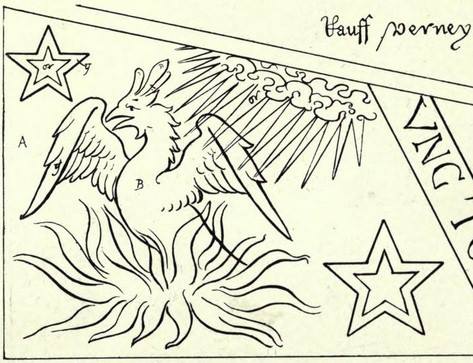Pierced
WARNING: Do not cite this page as a reference. This page is on this wikispace only to make the content "searchable" and easier to find. If you find the information you seek here, go to the original sources to verify the information and use them for your documentation.
Pierced means a hole has been put in a charge. For piercing in the sense of piercing something with something else, see Enfiled, Transfixed .
Illustrations:[edit | edit source]
Illustration from period source:
 "Banners, Standards and Badges from a Tudor manuscript in the College of Arms", p 138, banner with phoenix, sunburst, fimbriated/pierced mullets
"Banners, Standards and Badges from a Tudor manuscript in the College of Arms", p 138, banner with phoenix, sunburst, fimbriated/pierced mullets
[Illustration from PicDic]
Illustration/s from Brickbat's Armorial Stash - [[1]]:
Pennsic Traceable Art Project:
Parker's Heraldry:[edit | edit source]
Pierced, (fr. percé): applied to any bearing which is perforated, the tincture of the field or charged on which it is placed being seen through the aperture, (fr. ajouré). If a different tincture be seen it should be blazoned as voided. See e.g. examples under Mullet.
As to the form of the aperture it is doubtful as regards the ancient arms whether it should be circular, or should follow the outline of the charge. In modern arms pierced implies a circular aperture, though Crosses are sometimes square pierced, and lozenge pierced. See §9, and §5; and voided is used when the aperture follows the outline.
Pierced with an arrow generally means the same as transfixed. A singular, and perhaps single, instance of an ordinary piercing or perforating another is:– > Or, chevron gules pierced with [or perforated by] a bend ermine[otherwise a bend ermine perforating a chevron gules]–HODSTOKE, or HADSTOCK, Suffolk.
[[2]]
Precedents:[edit | edit source]
From the August 2003 LoAR: "[A billet argent] This does not conflict with the badge of Rowena of Jorvik, (Fieldless) A delf argent pierced two and two. There is one CD for fieldlessness and another for the sizeable piercing. As noted in the LoAR of December 1999, 'After much thought, we decided that piercing is worth a CD when drawn large enough to be equivalent to adding a tertiary charge, as it is done here; i.e. when it is clearly visible and takes up much of the space available to it.' " [2003 LoAR]
From the April 2003 LoAR: "We have blazoned the cinquefoil as pierced because we believe that it is standard SCA practice to blazon this detail. Piercing of cinquefoils was likely due to artistic license in some portions of our period, and is not worth difference." [2003 LoAR]
From the January 2000 LoAR: "Current precedent is that we only allow the piercing of charges on fieldless badges when those charges were found pierced in period armory (thus disallowing omni-tinctured tertiary charges). While a compass star is closely related to a mullet, it is nevertheless a different charge, one not found in period armory. Therefore we are not inclined to give it the benefit of the doubt and allow it to be pierced as we would a mullet or spur rowel." [2000 LoAR]
From the December 1999 LoAR: [a compass star pierced] "After much thought, we decided that piercing is worth a CD when drawn large enough to be equivalent to adding a tertiary charge, as it is done here; i.e. when it is clearly visible and takes up much of the space available to it." [1999 LoAR]